Integrated Report 2021 (Digital Edition)
Employee Roundtable Discussion
Contribute to the Solution of Social Issues through SSCV
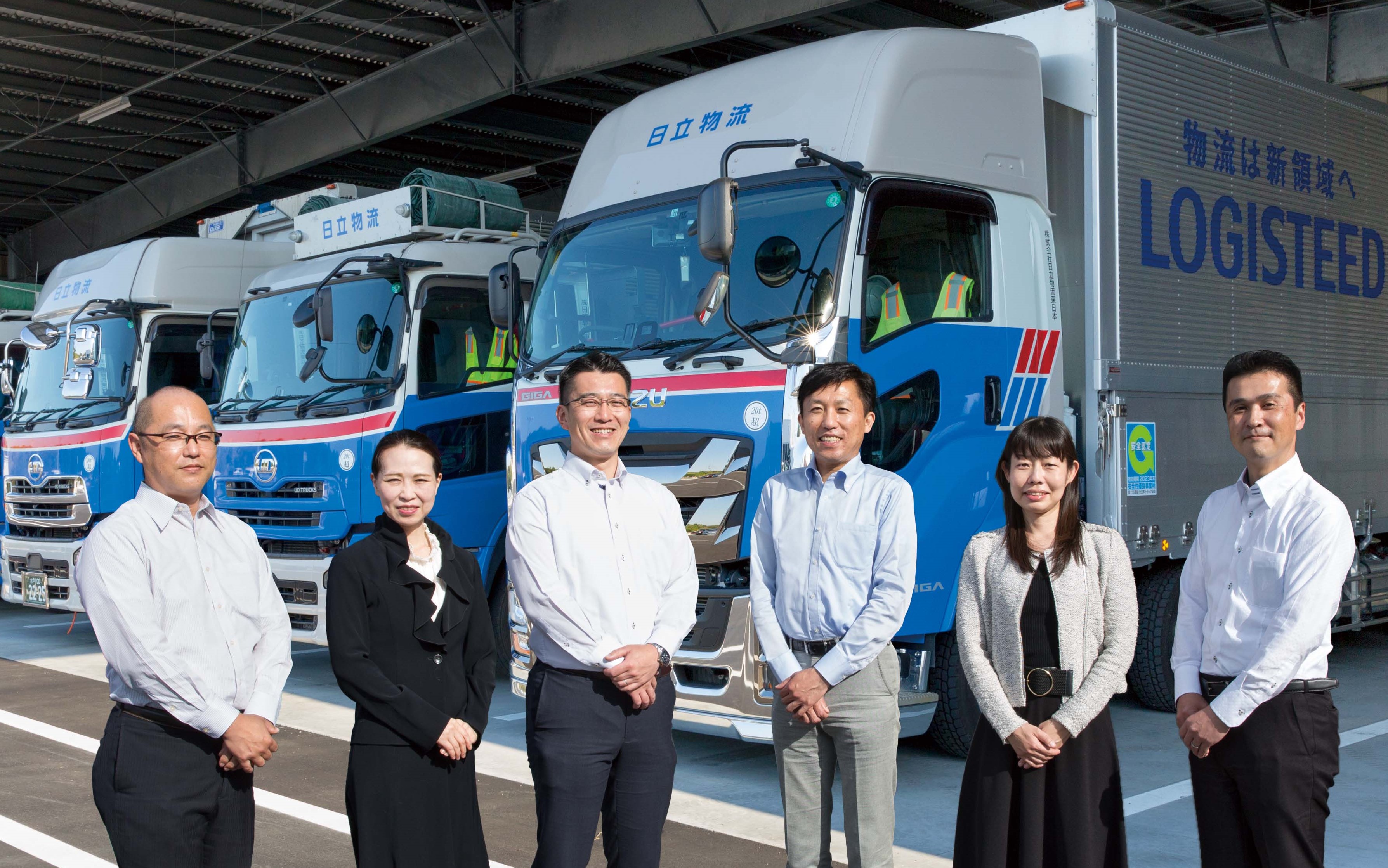
Smart & Safety Connected Vehicle (SSCV) is a transport digital platform that the HTS Group develops and provides to realize "sustainable transportation services" and "zero-accident society."
With on-site data collection and industry-government-academia collaboration as the starting point, we have rolled out the following three services with an aim to solve social issues and create economic value.
SSCV-Smart = Order management, vehicle assignment management, and driving management
SSCV-Safety = Safe driving management
SSCV-Vehicle = Optimization of vehicle management, failure prediction and preventive maintenance For this report, we held a roundtable discussion mainly with members who participated in development and installation of SSCV.
Attendees in the discussion
General Manager, Smart & Safety Connected Vehicle Enhancement Department, Transport Business
Enhancement Project Team, Business Management Headquarters
Hideaki Nagumo
Department Manager, Smart & Safety Connected Vehicle Enhancement Department, Transport Business Enhancement Project Team, Business Management Headquarters
Kiminori Satoh
Assistant Manager, Smart & Safety
Connected Vehicle Enhancement Department, Transport Business Enhancement Project Team, Business Management Headquarters
Hiroshi Obinata
Manager, Intellectual Property Group, Legal Department, Human Resources & Business Support Office
Tomoko Suzuki
Manager, Corporate Strategy Department, Corporate Strategy Office
Naoko Goto
Deputy General Manager, Transport Department, Ibaraki Division, Hitachi Transport System East Japan
Yoichi Maeda
*Names of organizations and positions are as of the date of the discussion.
First, please tell us about your career and what you do in this team.
Nagumo: For the first around 10 years after I joined the Company, I was engaged in the shipment and transport of ICT equipment of Hitachi, Ltd. For the next 10 years, I was in charge of launching a new business in the ICT solution business. It was a new business covering delivery/storage of ICT equipment, kitting, and installation and operation check at delivery destinations, which was great experience for me. After that, I oversaw the management of 3PL, solution business, and transport business as a General Manager of Keihin Sales Office and then worked at the Digital Business Development Department, etc. before joining the Smart & Safety Connected Vehicle Enhancement Department. And now, I am overseeing this project as a General Manager.
Satoh: After I joined Hitachi Distribution Software, I was seconded to HTS's subsidiary in Singapore for around eight years, where I was engaged in the development and maintenance of warehouse management system of subsidiaries in Southeast Asia. Since the end of 2016, I was seconded to HTS, and in the SSCV project, I am in charge of the system development and system linkage by cooperating with academics and vendors.
Maeda: I joined Hitachi Transport System East Japan as a driver and was engaged in transportation of home appliances and hazardous products for the first two years and in the transportation planning for the next seven years. Since FY2011, I worked as a manager in transport sales offices in Mito and Hitachi, Ibaraki Prefecture. After transferred to the Planning Section of Transport Department, as it coincided with the renewal of existing systems in Hitachi Transport System East Japan, I worked with the SSCV Team in the development of SSCV-Smart. Now, I am promoting sales expansion of it to partner companies.
Goto: After working as an asset manager in a real estate fund management company handling REIT, etc. I joined HTS in 2018. I was engaged in developing an overall real estate strategy and launching "LOGISTEED CAFE*1" at Kyobashi Head Office. In SSCV, my mission is to expand and deepen CSR domains to be created by this business, in other words, Creating Shared Value (CSV).
Obinata: After working as a driver and a driving manager and engaging in the warehouse management, etc. in two logistics companies, I joined HTS in 2020. In the SSCV Team, I am in charge of sales and proposing installation of SSCV to customers and sale on approval.
Suzuki: Before I joined HTS in 2017, I was in charge of patent applications and infringement lawsuits in the intellectual property division of an electric and precision instruments manufacturer. In SSCV, I am responsible for protecting services that our team has devoted so much effort to through various applications, intellectual property right protection, and risk control, etc.
*1: Open innovation facility established in the head office building in December 2020 as part of the collaborative innovation strategy P.28
I see the team is made up of experts in various fields.
What made you think of developing SSCV in the first place?
Nagumo: The origin of SSCV was three rear-end collisions that happened in a row within just five months in 2015 when I was a site manager. Trucks crashed into the rear of the cars in front without applying the brakes in all three cases. When we checked their dashboard camera footages, none of the drivers were dozing off, distracted or using a mobile phone while driving, but they crashed even though they were looking ahead. When the drivers were interviewed, it was found that they suffered from chronic mental exhaustion due to sickness of family members or caring of their parents. Based on these, it was suspected that mentally unstable drivers "are not seeing anything although their eyes are open," causing an "absent-minded driving." These factors were not identified in face-to-face roll-call before driving, and drivers themselves were not aware of it.
What do you think of it as a driver?
Maeda: We, drivers, have a sense of responsibility or mission that we will deliver cargoes we load. Therefore, we feel that we are responsible for delivering cargoes even if we are not feeling well or have some family problems. From the standpoint of a driving manager, because of the driver shortage at sites, we were not able to provide the environment where drivers could say at roll-call, "I can't drive today."
Obinata: Me neither. When I was working as a driver, I could never say, "I don't want to drive because I am tired." If I couldn't deliver, I had to ask someone to cover for me. And I also didn't want others to step in my delivery area.
Nagumo: Statistics of the Ministry of Land, Infrastructure, Transport and Tourism of Japan also showed a rapid increase in the number of transport accidents attributable to drivers' health problem since around 2015, which made us think that social environment may be the cause of these accidents. However, we had to do something because driver shortage and aging drivers were becoming serious issues. Those three successive accidents were just rear-end collisions as there happened to be cars in front of them, but they could have hit someone or the drivers could have lost their lives. If the cargoes are not delivered safely to their destination, the original mission of logistics service provider is not fulfilled.
So, safety management is not an easy job if you consider drivers' feelings and on-site culture.
Nagumo: Yes. And keys to solve this issue are "quantification" and "visualization." Previously, driving managers had no way of knowing the drivers' situation while driving, so they had no choice but to leave safety management to drivers once vehicles left the office. But then we thought using AI and IoT devices might make it possible to completely visualize "fatigue" and "driving behavior" while driving in real time, and we could protect drivers as a company - that's how we started the development of SSCV.
Next, please tell us about the services of SSCV.
Nagumo: SSCV consists of three services of SSCV-Smart, SSCV-Safety, and SCV-Vehicle ("Smart," "Safety," and "Vehicle," respectively). The transport business consists of three factors of "driving plans," "drivers' safety," and "trucks," and SSCV supports them. Smart which supports "driving plans" helps transporters improve operational efficiency and enhance compliance by digitalizing order management, etc. "Safety" comprehensively supports the safe driving management through AI-based analysis of drivers' vital signs and driving data. Vehicle is a solution that achieves failure prediction and preventive maintenance of vehicles by digitalizing the vehicle management and maintenance records and obtaining real-time driving data for statistical analysis.
First, please explain features of Safety, the origin of SSCV.
Nagumo: Heinrich's law*2 states "for every accident that causes a major injury, there are 29 accidents that cause minor injuries and 300 accidents that cause near-misses (Hiyari-Hatto)," but Safety aims to achieve "zero-accident" by visualizing and eradicating not just accidents but near-misses. The most notable feature is that it incorporates a logic backed by fatigue science that sends a near-miss alert to drivers based on objective data including their physical conditions and fatigue levels on the basis of the research findings on the correlation between drivers' vital signs and vehicles' abnormal behaviors. During the initial stage of the project in 2016 and 2017, we collected all products that send a reminder to drivers from Japan and overseas and had the Company's drivers try them. However, we couldn't find the product that had all functions we wanted, so we decided to develop it ourselves.
*2 A theory about workplace accidents introduced by Herbert William Heinrich who was working in the engineering and inspection division of a non-life insurance company in the U.S.
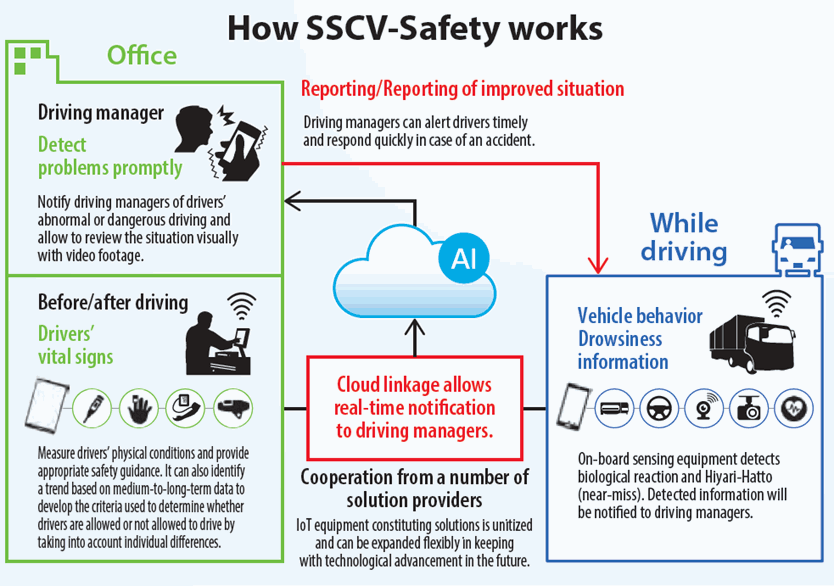
Satoh: Then, we met Professor Hirohiko Kuratsune of Osaka City University, an authority of fatigue science, and he proposed, "A research on correlation between vital signs of drivers while driving and fatigue is the first in the world. Can we do it together?" As a result, a joint research including RIKEN has started in 2018. This collaboration brought a great advantage for us. Analysis and research on the relation between autonomic nerve function and physical condition have been conducted since before the World War II, but because most data were obtained in indoor researches, they could not be applied to an environment with lots of noise and vibration that are unique to automobiles. Thanks to this academic-industrial collaboration, we were able to collect sufficient amount of vital signs of drivers before/after/while driving and vehicles' behaviors, and we summarized the analytical findings in a paper and published it after a peer review by a third party professor.
Nagumo: For your information, we collected around 4,000 person-days of before/after driving data and 1,200 person-days of while driving data.
Such support of academic research must be one of the most notable features of Safety, isn't it?
Satoh: Yes. We incorporated academic logic and built the system together with the sites through trial and error. After a prototype was completed, we held regular meetings with executives twice a month and advanced the development with advice and wisdom from various people, but there were more than a few times that we had to make a course correction by scrapping what we built. Through these efforts, we were able to put logic of sophisticated academic research and on-site voices into the system, and that is the feature and sales point of Safety. Safety enables to present near-misses prediction while driving based on the objective data such as drivers' physical conditions and fatigue levels using a collision risk estimation algorithm backed by academic research. It is also equipped with functions that detect near-misses that may cause accidents in real time by obtaining vehicles' status while driving and drivers' stress levels using IoT-based dashboard cameras or wearable devices and issue a warning sound in case of reckless driving or dangerous situation.
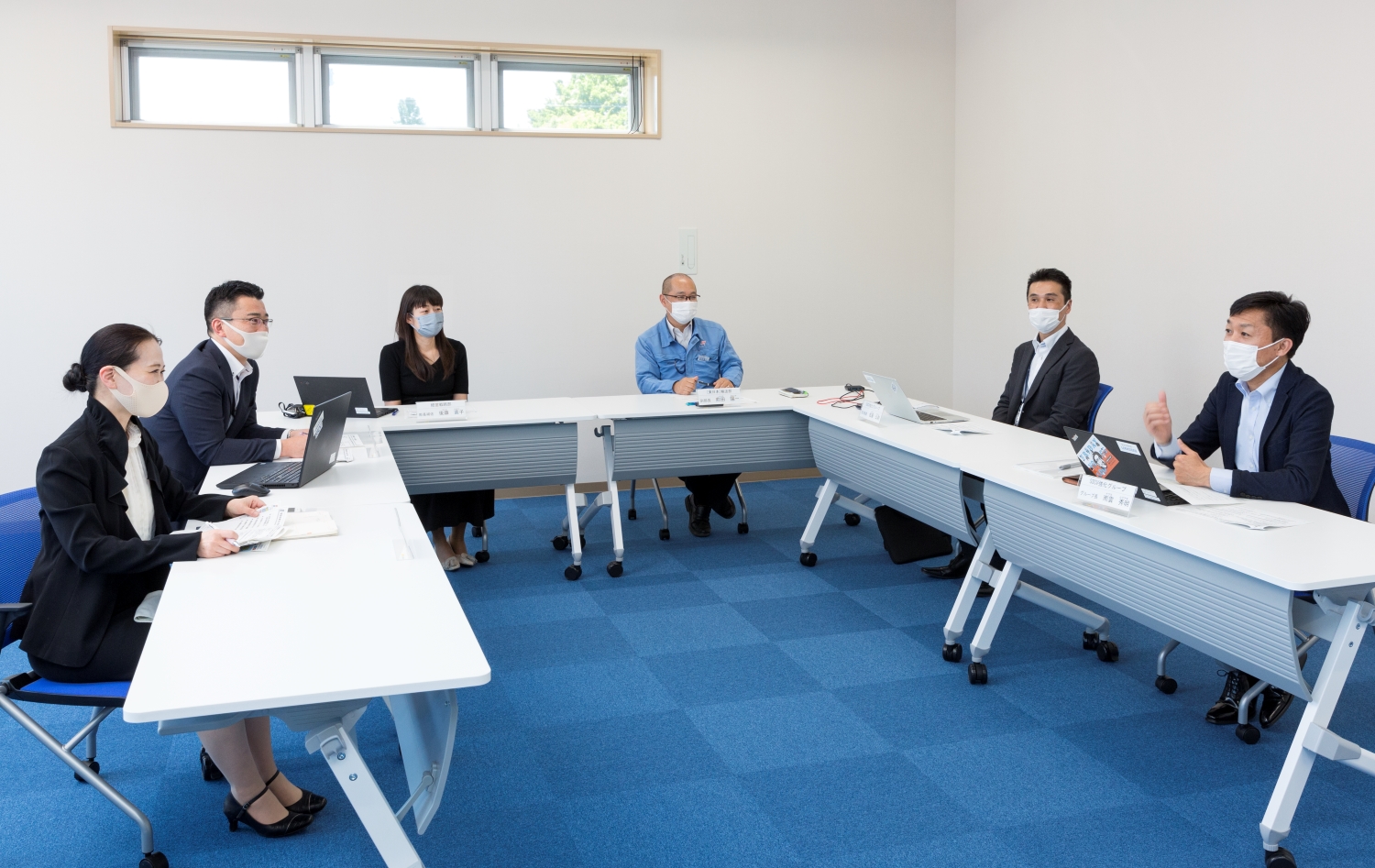
Roundtable discussion (Mito Transport Center)
How did drivers react when Safety was installed?
Maeda: Hitachi Transport System East Japan installed Safety in its all vehicles. Because one of the advantages of being a driver is that you can be alone while driving, there were a great deal of resistance from drivers to the idea of being watched through the camera all the time at first. So, driving managers patiently talked to each driver and managed to convince them that it was a tool to protect them, not to monitor.
Nagumo: I also explained our view carefully at workplace meetings that "it is for protection and not for monitoring" and "we do not want any driver of the Group to become an assailant or victim." And I think because we showed drivers some videos of the accidents we caused, they probably started thinking, "If Smart can prevent such accidents." We completed the installation in all around 1,300 vehicles of our group companies, and in FY2021, we plan to install it in around 3,600 vehicles in partner companies.
Please tell us about specific example of the effects of the installation of Safety.
Obinata: Since the installation in June 2019, there has been no accident due to absent-minded driving with Safety-installed vehicles. According to the fixed-point observation of one of our offices, the number of near-misses including sudden start, sudden braking, and sudden steering declined by 94%.
Nagumo: At this point, the number of accidents decreased approximately 60%, which contributed to a decline in accident-related expenses. Decreases in sudden start, sudden braking, and sudden steering, etc. are also helping us realize eco-driving. In one of our group companies, fuel efficiency improved by approximately 5% in full-year data, which shows that Safety is contributing to not only safety but also a reduction of CO2 emissions and decarbonization.
Maeda: As a qualitative effect, drivers and driving managers previously used to exchange only a few words after drivers return to offices, but now the communications between them are invigorated because they review the SSCV data together.
Nagumo: It is because driving managers can give advice by watching the camera footage of actual driving of that day. For example, a driver who tends to make sudden steering frequently may not be aware of it, but because it is plain to see on the video, the driver can correct it. Safety education was only a generalization before, but now we can give guidance according to driving habit of each driver.
Maeda: The following distance between vehicles which is important for safety driving tends to be closer with experienced drivers. Drivers may disagree when we simply point it out, but when we show the data showing that "their distance is closer" than others they agree.
Nagumo: In addition, because the system shows a two-week average value of the drivers' vital signs, drivers pay attention to the scores and are becoming health conscious.
Satoh: It also helps us to prevent the spread of COVID-19. It shows the body temperature with the difference from the average over the last 30 days and saves data of blood oxygen levels, which is very helpful in providing drivers' information to customers and also giving reassurance to drivers themselves.
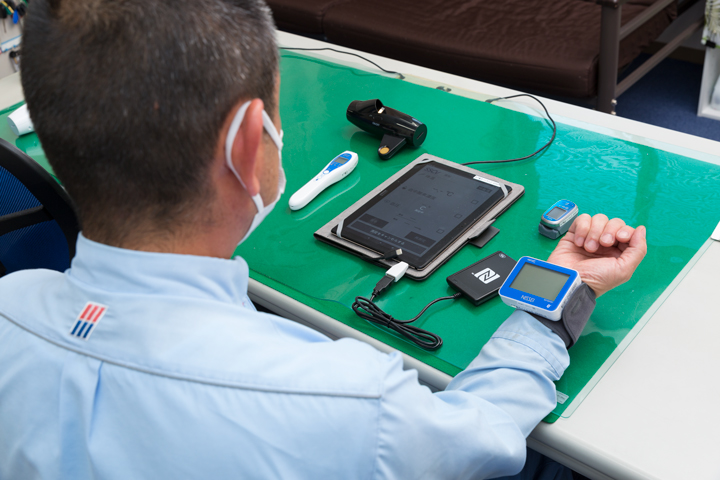
Measurement at roll-call befor driving
I understand that Safety has various advantages. Please tell us about an intellectual property strategy to protect such value in business.
Suzuki: In 2017 when we started to prepare for patent application of Safety, the Company's patents were mainly related to warehouse management and operation support systems. So, I was really surprised when I was told the Company aimed to apply for patents related to the transport business, and I wasn't sure if it was possible at first. After we spent six months to carefully examine the details of the applications, we applied for two patents of "accident risk notification" and "notification with dashboard camera video clip" for the system which predicts accident risk and notifies driving managers when it determines an accident risk is really high and dangerous, and they were registered. In addition, we have around 10 patents pending mainly related to Safety. We also have several pending applications for trademark registration. While "Hitachi Transport System" and "LOGISTEED" were registered in five areas, we applied for and obtained registration of SSCV in eight areas to expand the scope of services. We believe that the Company has an advantage that it can provide services and value needed at the sites because its primary business is logistics. We will ensure to incorporate such advantage in our intellectual property strategy to proceed with patent application and acquisition of rights.
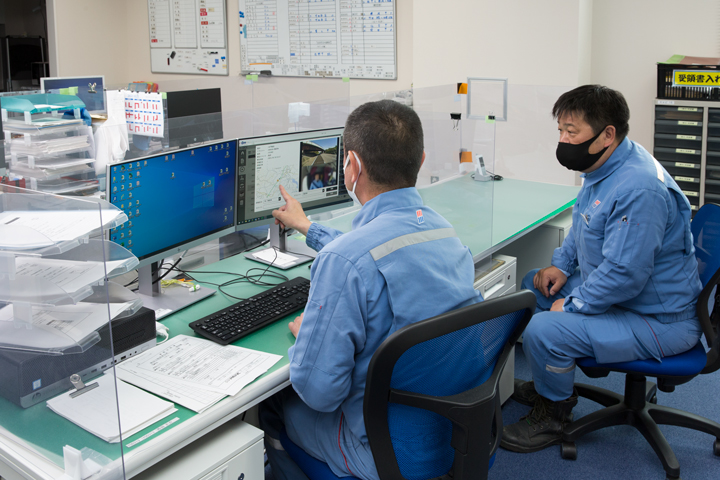
Review by a driving manager and a driver
Next, please tell us about Smart.
Nagumo: We have developed Smart by focusing on improving transportation/delivery efficiency and enhancing compliance. One of the hidden priority issues in the transport industry is that many operations are performed manually. Needless to say, it is inefficient, and violation of laws due to insufficient paperwork may result in situations such as suspension of vehicle operations. In Japan, there are approximately 62,000 trucking companies, of which about 90% has less than 50 employees. To improve operating efficiency of small and medium-sized transporters will lead to CSV from the viewpoint of not stopping logistics in Japan. To proactively support them, the Company has focused on developing Smart by taking into account their requests and opinions. We offer Smart as a cloud-based service that digitalizes operations including receiving/making orders, vehicle assignment management, driving plans/instructions, and billing, allowing to use all functions with one login as long as it is online.
Just like Safety, it is an example of external DX in anticipation of creating shared value. What is the status of installation of Smart?
Nagumo: It was released in October 2020 and has been installed in the Group and its partner companies since April 2021.
Maeda: Because it has just started, we are receiving all different kinds of opinions from users. In the logistics industry, 10 companies have 10 different ways of operation, with each wanting a system to be matched to their way. Currently, our development team has been struggling to make adjustments in a bid to find the greatest common factor.
Nagumo: We received a report that they were able to eliminate posting errors or omissions and delivery arrangement errors thanks to digitalization and full paperless operations. We believe that we will be able to see quantitative effects gradually.
Next, please tell us about the overview of Vehicle and the current initiatives.
Nagumo: Vehicle promotes DX for vehicle management and maintenance. It improves the vehicle utilization rate and reduces management processes through visualization and digitalization of vehicle management and maintenance records. In addition, it collects and statistically analyzes data while driving in real time to sophisticate vehicle maintenance, and eventually achieve failure prediction and preventive maintenance. We are developing the systems with an aim to install a system that visualizes vehicle management and maintenance records in FY2021 and to achieve data-driven preventive maintenance in FY2022. In addition, our group company Hitachi Auto Service launched a fixed price maintenance service for group companies and partner companies. We will increase users and offer a fixed price maintenance service together with data-driven failure prediction and preventive maintenance functions in hopes to prevent small and medium-sized transporters from incurring loss costs or opportunity losses due to vehicle failures.
Please tell us about the future development plans for these three services of SSCV and cross-industry collaboration.
Satoh: Currently, relevant ministries and agencies, etc. have been discussing how to sophisticate driving management using ICT and how to improve drivers' working conditions, which we think will expand the potential for the use of Safety. Going forward, we will work on improving convenience and reducing costs. For devices to measure drivers' vital signs while driving, we are eying developing a smartwatch-type device in addition to the existing shirt-type device. For the measurement before/after driving at office, we hope in the future to realize a system that allows busy drivers to measure vital signs while doing other things by connecting the device to drivers' smartphones, etc.
Nagumo: Another development is for education services. We are working with our collaborative innovation partners to build an education service matched to characteristics of individual drivers by using data collected by SSCV. For Smart, we will enhance its mobile functions to register driving records with smartphones, etc. and visualize loading ratios. In addition, in preparation for the Amended Act on Book and Record Keeping through Electronic Methods to be enacted in January 2022, we will enhance its electronic storage functions and also have a plan to develop a financial service to provide financial support to small and medium-sized transporters.
Goto: Currently, our cross-industry collaboration for SSCV has two objectives. First one is to enhance functions so that SSCV can be used widely in various scenes of transport. We have installed SSCV in vehicles of a food delivery company, a bus company, and garbage trucks of a municipality to conduct a joint study for additional functions. We are also working with non-life insurance companies to develop a scoring function for safe driving. The second one is to deliver social value by using various data accumulated through SSCV. I'll give you an example of the initiative with the Ministry of Health, Labour and Welfare (MHLW). MHLW is now considering reviewing its notification on improvement criteria for drivers' working conditions with an aim to shorten drivers' working hours, and they are interested in vital signs showing drivers' fatigue status while driving that can be obtained by SSCV, which are now used in a medical survey of drivers' actual fatigue level conducted by MHLW.
Is there anything else you would like to share with us about the value that SSCV can deliver?
Goto: In terms of contributions to SDGs, SSCV can deliver two types of values: one that can be created in the short term and another that can be created in the medium-to-long term. The value that can be created in the short term is an improvement of operational efficiency and compliance by using Smart and the enhancement of safety by using Safety. In the medium-to-long term, I hope SSCV can contribute to the reduction of CO2 emissions by eco-driving, as well as the increase in potential young/female drivers and promotion of diversity in the entire logistics industry, through the enhancement of employees' health consciousness and the implementation of health-focused management.
Lastly, please tell us briefly about your future plans and challenges.
Nagumo: SSCV first started for the purpose of enhancing safety and eradicating accidents in the Group, but I believe it can also contribute to the solving of issues faced by the entire logistics industry. In order "not to stop" logistics that is essential social infrastructure or in order to realize "sustainable logistics," we will focus on further enhancement and development of SSCV functions. I will continue to take issues and opinions of transporters seriously and work to add and extend functions and services with higher added value.
Satoh: I recognize that SSCV is a solution that takes a step forward from the conventional logistics business and that is also quite important and meaningful in promoting the Group's DX. As a system developer, I will continue to cooperate with various collaborative innovation partners including academics and support the development of services that will offer values to stakeholders including the Group and other transporters.
Maeda: Driver shortage, safety management, and streamlining of transport operation will continue to be issues for the entire domestic logistics industry including us, and I think what's really important is how we can help small and medium-sized transporters with SSCV. I will continue to focus on expanding SSCV sales to partner companies and also enhance support for transporters who do not have sufficient resources to promote DX, with an aim to reach the level where transporters think "all we need for the transport business is SSCV." I will continue to work with my team toward that aim.
Goto: I will work to expand and deepen CSV initiatives through SSCV. I hope to enhance our capability to create values not only for the Company but also for SSCV users, and will strive to create shared value in the entire transport industry through the use of SSCV. In addition, I will cherish a network with a wide variety of industries in hopes to spread the use of SSCV to a wide range of sectors and industries other than logistics.
Obinata: I will continue to introduce and share various features of SSCV to the world, and I think it would be great if we could add other functions that offer compliment on safe driving. The current labor standard for drivers sets a uniform limit on work hours and consecutive driving hours regardless of their attributes or form of transport. By monitoring drivers' fatigue levels in real time using SSCV, we may be able to contribute to the realization of flexible working style according to the drivers' fatigue levels and an improvement of transport efficiency.
Suzuki: Originally, the focus of patent is to protect the business by seeking patents for R&D results. Recently, however, there is a movement that considers what is required for sustainable development of society and seeks patents for such ideas. I believe that is what the Group should do, so I will continue to acquire patents for various ideas to be generated by enhanced functions of SSCV, and I'd like to develop many personnel who will underpin the Company's future from the viewpoint of intellectual property.
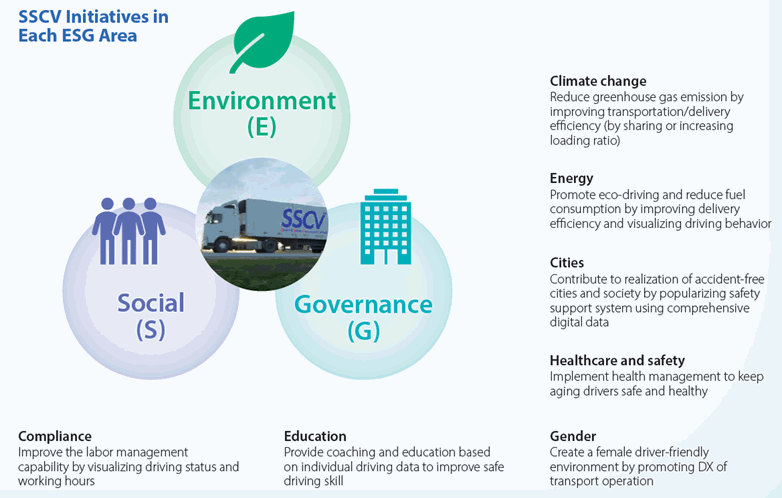
Contact us
Before submitting your inquiry, it is necessary for you to read our Privacy Policy and consent to its contents. If you agree to its contents, please contact us through this inquiry channel. Note that any personal information obtained will be deleted once your inquiry has been answered, and we will not hold it on file after that.
Inquiry about Investor Relations





